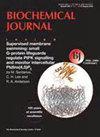Structural characterisation of a cysteine-rich conotoxin, sigma(σ)S-GVIIIA, extracted from the defensive venom of the marine cone snail Conus geographus.
IF 4.3
3区 生物学
Q2 BIOCHEMISTRY & MOLECULAR BIOLOGY
引用次数: 0
Abstract
The activity of the serotonin type 3 (5-HT3) receptor is associated with neurodegenerative, inflammatory and metabolic diseases, neuropsychiatric disorders, and cancer. Structural analysis of modulators of this receptor is likely to aid in future medicinal chemistry studies aimed at developing lead molecules targeting this receptor. Here we report the structure of a cone snail venom peptide that was purified from the crude venom of Conus geographus and shown to be an antagonist of the 5-HT3 receptor more than 25 years ago, sigma(σ)GVIIIA. This lag in structural characterisation studies is likely due to challenges in isolating the native peptide and difficulties in producing synthetic peptide due to the presence of ten cysteine residues involved in five disulfide bonds. Using NMR spectroscopy, we show that σS-GVIIIA adopts a growth factor cystine knot (GFCK) fold. This is the first example of a cone snail venom peptide experimentally determined to contain the GFCK structural motif, and the first example of a 5-HT3 receptor antagonist containing this motif. Our study also highlights complexities in the use of artificial intelligence-based structure prediction models. Peptide structure predictions using AlphaFold 3 were consistent with our NMR structure when the input sequence contained the well-conserved precursor sequence, but inconsistent when the precursor sequence was excluded. AI-based structure prediction of proteins is a rapidly advancing field, but this inconsistency emphasises the need for more experimental structural training data when novel structures are involved, as was the case here for a cysteine-rich peptide.从海锥螺防御毒液中提取的一种富含半胱氨酸的螺毒素sigma(σ) s - gviii的结构特征。
5-羟色胺3型(5-HT3)受体的活性与神经退行性疾病、炎症和代谢疾病、神经精神疾病和癌症有关。该受体调节剂的结构分析可能有助于未来的药物化学研究,旨在开发针对该受体的铅分子。在这里,我们报道了一个圆锥蜗牛毒液肽的结构,该肽是从圆锥蜗牛的粗毒液中纯化出来的,并在25年前被证明是5-HT3受体的拮抗剂,sigma(σ) gviii。这种结构表征研究的滞后可能是由于分离天然肽的挑战以及由于五个二硫键中存在十个半胱氨酸残基而产生合成肽的困难。通过核磁共振波谱分析表明,σ s - gviia采用生长因子胱氨酸结(GFCK)褶皱。这是第一个通过实验确定含有GFCK结构基序的锥体蜗牛毒液肽,也是第一个含有该基序的5-HT3受体拮抗剂的例子。我们的研究还强调了使用基于人工智能的结构预测模型的复杂性。当输入序列包含保守性较好的前体序列时,使用AlphaFold 3预测的肽结构与我们的NMR结构一致,但当前体序列被排除时,预测结果不一致。基于人工智能的蛋白质结构预测是一个快速发展的领域,但这种不一致性强调了当涉及到新的结构时,需要更多的实验结构训练数据,就像这里富含半胱氨酸的肽的情况一样。
本文章由计算机程序翻译,如有差异,请以英文原文为准。
求助全文
约1分钟内获得全文
求助全文
来源期刊

Biochemical Journal
生物-生化与分子生物学
CiteScore
8.00
自引率
0.00%
发文量
255
审稿时长
1 months
期刊介绍:
Exploring the molecular mechanisms that underpin key biological processes, the Biochemical Journal is a leading bioscience journal publishing high-impact scientific research papers and reviews on the latest advances and new mechanistic concepts in the fields of biochemistry, cellular biosciences and molecular biology.
The Journal and its Editorial Board are committed to publishing work that provides a significant advance to current understanding or mechanistic insights; studies that go beyond observational work using in vitro and/or in vivo approaches are welcomed.
Painless publishing:
All papers undergo a rigorous peer review process; however, the Editorial Board is committed to ensuring that, if revisions are recommended, extra experiments not necessary to the paper will not be asked for.
Areas covered in the journal include:
Cell biology
Chemical biology
Energy processes
Gene expression and regulation
Mechanisms of disease
Metabolism
Molecular structure and function
Plant biology
Signalling
 求助内容:
求助内容: 应助结果提醒方式:
应助结果提醒方式:


